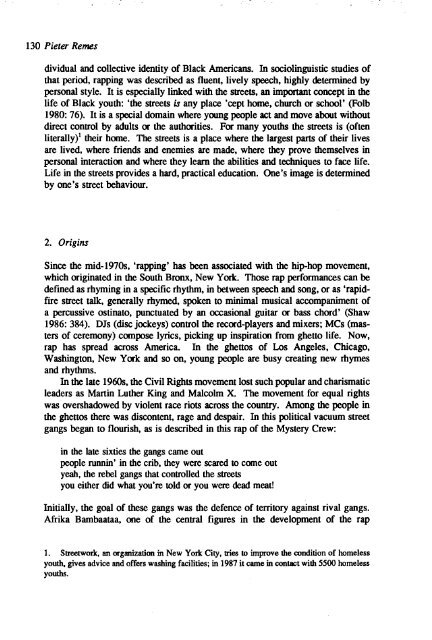1991 No. 1 CONTENTS - Institute of Social and Cultural ...
1991 No. 1 CONTENTS - Institute of Social and Cultural ...
1991 No. 1 CONTENTS - Institute of Social and Cultural ...
Create successful ePaper yourself
Turn your PDF publications into a flip-book with our unique Google optimized e-Paper software.
130 Pieter Remes<br />
dividual <strong>and</strong> collective identity <strong>of</strong> Black Americans. In sociolinguistic studies <strong>of</strong><br />
that period, rapping was described as fluent, lively speech, highly detennined by<br />
personal style. It is especially linked with the streets, an important concept in the<br />
life <strong>of</strong> Black youth: 'the streets is any place 'cept home, church or school' (Folb<br />
1980: 76). It is a special domain where young people act <strong>and</strong> move about without<br />
direct control by adults or the authorities. For many youths the streets is (<strong>of</strong>ten<br />
literally)l their home. The streets is a place where the largest parts <strong>of</strong> their lives<br />
are lived, where friends <strong>and</strong> enemies are made, where they prove themselves in<br />
personal interaction <strong>and</strong> where they learn the abilities <strong>and</strong> techniques to face life.<br />
Life in the streets provides a hard, practical education. One's image is detennined<br />
by one's street behaviour.<br />
2. Origins<br />
Since the mid-1970s, 'rapping' has been associated with the hip-hop movement,<br />
which originated in the South Bronx, New York. Those rap performances can be<br />
defined as rhyming in a specific rhythm, in between speech <strong>and</strong> song, or as 'rapidfire<br />
street talk, generally rhymed, spoken to minimal musical accompaniment <strong>of</strong><br />
a percussive ostinato, punctuated by an occasional guitar or bass chord' (Shaw<br />
1986: 384). DIs (disc jockeys) control the record-players <strong>and</strong> mixers; MCs (masters<br />
<strong>of</strong> ceremony) compose lyrics, picking up inspiration from ghetto life. <strong>No</strong>w,<br />
rap has spread across America. In the ghettos <strong>of</strong> Los Angeles, Chicago,<br />
Washington, New York <strong>and</strong> so on, young people are busy creating new rhymes<br />
<strong>and</strong> rhythms.<br />
In the late 1960s, the Civil Rights movement lost such popular <strong>and</strong> charismatic<br />
leaders as Martin Luther King <strong>and</strong> Malcolm X. The movement for equal rights<br />
was overshadowed by violent race riots across the country. Among the people in<br />
the ghettos there was discontent, rage <strong>and</strong> despair. In this p:>litical vacuum street<br />
gangs began to flourish, as is described in this rap <strong>of</strong> the Mystery Crew:<br />
in the late sixties the gangs came out<br />
people runnin' in the crib, they were scared to come out<br />
yeah, the rebel gangs that controlled the streets<br />
you either did what you're told or you were dead meat!<br />
Initially, the goal <strong>of</strong> these gangs was the defence <strong>of</strong> territory against rival gangs.<br />
Afrika Bambaataa, one <strong>of</strong> the central figures in the development <strong>of</strong> the rap<br />
1. Streetwork. an organization in New York City, tries to improve the condition <strong>of</strong> homeless<br />
youth. gives advice <strong>and</strong> <strong>of</strong>fers washing facilities; in 1987 it came in contact with 5500 homeless<br />
youths.
















